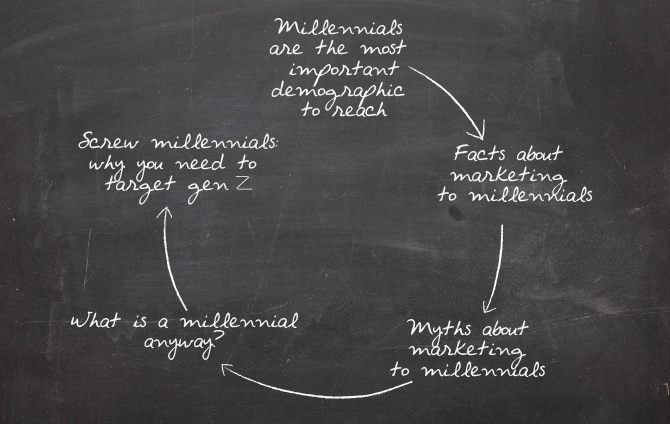
Talkin’ ’bout my generation: the trouble with defining target audiences
Posted on February 19, 2015 by Gabriella Rackoff
Every day there’s a new article about how to market to millennials, or baby boomers, or new moms – some target audience that marketers think they can dissect, peeling away the layers of the proverbial onion to get to the core of what makes people take out their wallets. Every day also brings a new crop of articles about how those other articles got it wrong.
Clickbait like
3 Marketing Myths That Make Millennials Hate Your Brand
has become
de rigueur
on the marketing blog circuit. It’s a cycle of promises that looks something like this:
 While every marketer and advertiser has to know who they’re speaking to, the problem with drawing conclusions about whole generations is that you’re aiming at a moving target; people change, society shifts, and individuals move from group to group (as millennials grow up and/or become parents, for example). There’s also the danger of misreading evidence and confusing cause and effect.
While every marketer and advertiser has to know who they’re speaking to, the problem with drawing conclusions about whole generations is that you’re aiming at a moving target; people change, society shifts, and individuals move from group to group (as millennials grow up and/or become parents, for example). There’s also the danger of misreading evidence and confusing cause and effect.
For example, one thing I read all the time is that millennials are narcissistic. The evidence seems to be that they post a lot of selfies. But would baby boomers have posted selfies if it had been an option? This is the generation behind the sexual revolution – they were changing the world and they knew it. I’m pretty sure there would have been a few mud-soaked topless selfies taken at Woodstock.
The other common mistake is to take a very common trait, like being price-conscious, and decide that it defines a generation. Almost everyone is price-conscious to a degree (even if they buy high-end, luxury items), but that’s not synonymous with spending as little as possible. This was one of the myths featured in the Inc. article mentioned above. A better way of putting it is value-conscious; people of all generations are willing to spend money on things that matter to them. But hasn’t that always been true, at every price level and in every economy?
There’s also the most obvious problem of trying to figure out who actually belongs to a target audience (I was born right at the beginning of the millennial generation and I often feel quite different from those crazy Snapchatting kids). So what’s the answer? I think it starts with what you’re selling. What are you really offering people? Everyone ultimately cares about what’s in it for them. If you’re making something cheap to appeal to millennials because you think that’s their main concern, you haven’t given them what they’re looking for. If the product offering isn’t up to par in terms of quality, design, or functionality, you’re not giving them value.
While media choices are a great way to find your target audience (hint: moms of young kids are all on Facebook) when you craft your messaging around assumptions about a large group, you could be getting it wrong. Start with how your product makes people’s lives better (easier, more beautiful, more fun) and they will find you.







Leave a Reply